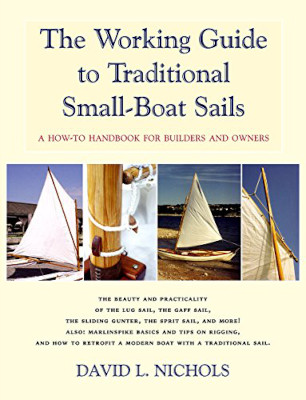
As a result of class and regatta handicapping requirements, the Marconi rig has more or less evolved into the default modern-day sail plan. But for many boatbuilders and sailors, a triangular jib paired with a larger triangular mainsail may not be the best choice, either aesthetically or for reasons of efficiency.
In this new volume from Breakaway Books, veteran boatbuilder David L. Nichols counsels that the best way to move your boat forward may be to look backward, to the sailing rigs of the past. As a boatbuilder and sailmaker with more than 15 years of experience, Nichols has put together a nuts and bolts guide to traditional sailing rigs that thoroughly explores the sails, spars, and rigging of numerous traditional sail plans.
Beginning with a basic treatise on sail anatomy and aerodynamics, the author establishes a fundamental understanding of the working properties of sails, before launching into any serious design discussion. This introductory section is followed up with an equally well-founded chapter on the importance of sound marlinespike skills. Nichols explains that from whipping a line to seizing an eye, good marlinespike skills may not only save you money, but could save your bacon when rigging fails., The book’s greatest asset is its detailed discussion of how to replace a modern sail plan with a traditional rig. In particular, the author includes the measurements and calculations needed to figure the Center of Effort for both modern and traditional sail. He then explains why this information is important, and how to use these figures to efficiently design your rig.
Specific sailing rigs covered in the book include the sliding gunter, sprit sail, a variety of lug sails, gaff sails, and a section on variants of traditional designs. In discussing each of the designs, the author stresses that they all represent a compromise and offer a unique set of tradeoffs. While he does discuss the advantages of different rigs and how they were originally used, Mr. Nichols is careful not to definitively discuss which sails work best on particular boats. He leaves it for the reader to decide which rig will fit his or her own vessel.
In the end, though the book has quite a few typos and small editorial glitches, it is packed with lots of clear photos, detailed instructions, and is a good first reference book for anyone wanting to study traditional sail plans. Mr. Nichols does an excellent job of explaining the fundamentals in terms that are useful to old salts looking to tweak their rigs, builders trying to figure out what’s next, and admirers of traditional design.
The Working Guide to Traditional Small-boat Sails: A How-to Handbook for Builders and Owners by David L. Nichols (Breakaway Books, 2006; 96 pages)




